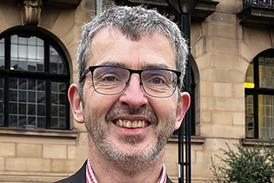The prime minister has insisted his government is now all about delivery, but the HSJ100 disagrees.
It is the centre — government and its arm’s length bodies — which dominates the top end of this year’s list, not the local NHS leaders, managers or clinicians who will actually be doing the delivering.
Sponsored by
This year’s list identifies the 80 people exercising most influence on the NHS and NHS policy over the coming 12 months, with only a small list of exclusions. We have identified and ranked the top 20 of those. Back in the spring, we selected a list of 20 ‘wildcards’, who judges and contributors said should have more influence, which takes us to our full 100.
Sajid Javid tops the 80, not Amanda Pritchard, who is second, even though she is closer to the sharp end of operations and was appointed by the government as an experienced and trusted ‘deliverer’.
This placement – and others in the top 20 – expose the reality that Mr Javid, along with other parts of Whitehall, will not be shy to put their own imprint on said delivery (witness the health and social care secretary’s early list of reforms and reviews), rather than simply leaving the health service to it.
There is also the fact that Ms Pritchard’s leadership style differs from her predecessor: Less calling all the shots and signing off every missive from her office, and more being guided by and delegating to her team.
Seventeen of the top 20 work for central agencies and eight of those for NHS England — both counts are the same as in 2018, the last comparable list. But in 2018, three of the top five were from NHSE, now it is just one, although a further three NHSE directors, including Ms Pritchard’s effective number two Julian Kelly (7), make the top 10.
Government fills the gaps
The consolidation of NHS Improvement into NHSE has cleared space in the top 20, as has the expectation of another quiet period for the Care Quality Commission, with its most prominent influencer, the chief inspector of hospitals, announcing his retirement.
But the vacuum has not been filled by top NHS trust leaders, for example, nor by regional directors (only two of the seven make the top 80), nor by emerging integrated care system bosses, of which only one — Rob Webster — makes the list. No ICS executive jobs have yet been confirmed, which hindered their cause, while two of our judges who are influential ICS leaders excluded themselves.
Instead of local leaders, it is the government moving in. Number 10 Downing Street has in particular made a raid at the top end. Samantha Jones (5) and Emily Lawson (at 6, the biggest climber since 2018) give the prime minister’s office an influence not matched since Paul Corrigan topped the first HSJ50, in 2006. The centre of government is under a lot of pressure to show returns on health and social care, and has tooled up with both expertise and delivery nous.
The Department of Health and Social Care occupies six of the top 20 places, up from four in 2018, including two in the top five (versus one in 2008). It has been bolstered by the ongoing importance of covid (putting Chris Whitty third and Jenny Harries, as Health Security Agency boss, in the top 20), by Edward Argar’s steady hand on the Health and Care Bill in parliament, and by its poaching of Matt Style (20) from NHSE. Mr Style’s ability, attitude and knowledge gained at NHSE have set hopes high. He will be a key voice on workforce, expected to be a big part of his brief, along with Health Education England’s Navina Evans (16), while NHSE chief people officer Prerana Issar is notably absent from the top 20.
Kings over the water
Only three people in the top 20 are from outside these national agencies — but two of them occupy quite astonishingly high positions given their current roles. Commons health committee chair Jeremy Hunt, at fourth, is higher than even Stephen Dorrell a decade ago when he used that position to torpedo the Lansley reforms, and is well above any former health secretary. Simon (now Lord) Stevens (11) comes higher than any ex-NHS chief exec in the past.
Neither have the sort of executive roles which normally warrant such positions, nor are they running substantial organisations. Although both will be careful how they use their power — and neither are trying to get their crown back — their presence at the centre of UK health policy will inevitably have an impact on their successors.
The judges also wanted to record that some figures who are not at the top table nationally, and still have one foot in the day job, were close to making it into the top 20. They included Bola Owolabi, the GP and NHSE inequalities director who has been making a splash well beyond her pay grade, and Sir Jim Mackey, who has just joined NHSE as an elective care adviser in addition to his trust CEO job.
But outside influencers such as unions and professional groups, except for NHS Providers’ Chris Hopson, are squeezed out of the top 20 — a surprise result, maybe, given current tensions over staff pay and burnout, and general practice in particular.
Diversity starts at the top
Aside from at the very top of the shop, gender and ethnic diversity are not greatly improved. There are more than double as many men (54) as women (26) in the 80. In 2018 there were 30 women in the HSJ100, so there is no discernible improvement there. There are eight women in the top 20, up from six three years ago. There are two in the top five (and three in the top six), up from none.
In the entire 80 there are 14 people (less than a fifth) known to be from a minority ethnic background — that’s up from six in 2018. In the top 20 there are just three, although they include the first health secretary with an ethnic minority background in the top spot, which is up from one (Chaand Nagpaul) in 2018.
Leedsing the way
A special mention for Leeds and West Yorkshire which have four local leaders in the HSJ80 (Julian Hartley, Dame Linda Pollard, Tom Riordan, and Rob Webster) — one fewer than London (Ian Abbs, Kevin Fenton, Claire Murdoch, Sir David Sloman and Dame Alwen Williams) — giving at least one potential counterweight to Whitehall.
Also read:
HSJ100 reveals this year’s enablers of transformations
HSJ100: Government is back
- 1
 Currently reading
Currently readingHSJ100: Government is back
- 2
- 3
- 4
- 5































No comments yet